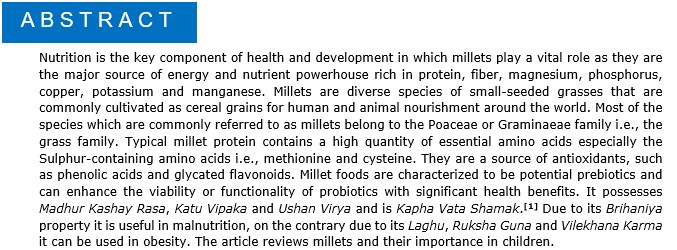Empowering kids with Millet
DOI:
https://doi.org/10.21760/jaims.8.10.18Keywords:
Millets, Nutrition, Obesity, ChildrenAbstract
Nutrition is the key component of health and development in which millets play a vital role as they are the major source of energy and nutrient powerhouse rich in protein, fiber, magnesium, phosphorus, copper, potassium and manganese. Millets are diverse species of small-seeded grasses that are commonly cultivated as cereal grains for human and animal nourishment around the world. Most of the species which are commonly referred to as millets belong to the Poaceae or Graminaeae family i.e., the grass family. Typical millet protein contains a high quantity of essential amino acids especially the Sulphur-containing amino acids i.e., methionine and cysteine. They are a source of antioxidants, such as phenolic acids and glycated flavonoids. Millet foods are characterized to be potential prebiotics and can enhance the viability or functionality of probiotics with significant health benefits. It possesses Madhur Kashay Rasa, Katu Vipaka and Ushan Virya and is Kapha Vata Shamak.[1] Due to its Brihaniya property it is useful in malnutrition, on the contrary due to its Laghu, Ruksha Guna and Vilekhana Karma it can be used in obesity. The article reviews millets and their importance in children.
Downloads
References
Acharya Charaka. Sutrasthana, Annapanavidhi Adhyaya. In: Vaidya Jadavaji Trikamji Acharya (ed.) Charaka Samhita. Delhi: Chaukhambha Prakashan; 2011; p. 154.
Ambati K, Sucharitha KV. Millets – Review on Nutritional profiles and Health benefits. Int J Recent Sci Res. 2019 Jul;10(7):33943–8.
Gull A, Jan R, Nayik GA, Prasad K, Kumar P. Significance of Finger Millet in Nutrition, Health, and Value-added Products: A Review. J Food Process Technol. 2014;3:1601–8.
ICAR – Indian Institute of Millets Research. 2017.
Kalinova J. Nutritionally important components of Porso millets (Panicum miliaceum L.) food. Global Sci Books. 1(1):91–100.
Reddy OSK. Smart Millet and Human Health. Green Universe Environ Serv Soc. 2017.
Deshpande SS, Mohapatra D, Tripathi MK, Sadvatha RH. Kodo millet - Nutritional Value and Utilization in Indian Foods. J Grain Process Storage. 2015;2.
Bhavamishra. Dhanyavarga. In: Dr. K.C. Chunekar (cm.), Dr. G.S. Pandey (ed.) Bhavaprakasha Nighantu. Varanasi: Choukhambha Bharti Academy; 2002; p. 656–61, 667.
Millet India [Internet]. [cited 23]. Available from: http://milletsindia.org
Indian Institute of Millet Research (IIMR), Hyderabad.
Bommy D, Kavitha Maheshwari S. International Journal of Current Research and Academic Review.















